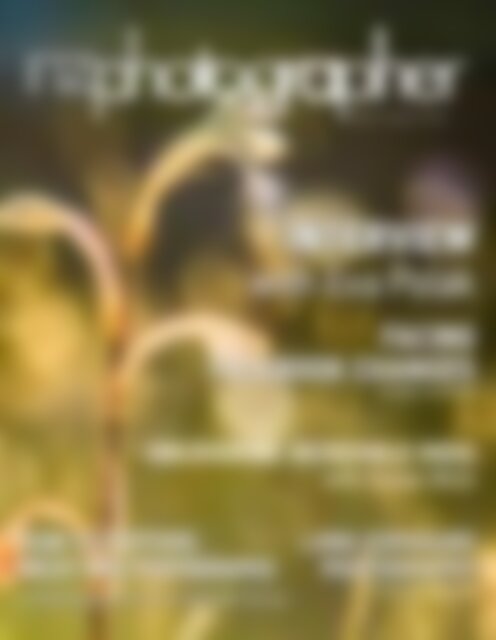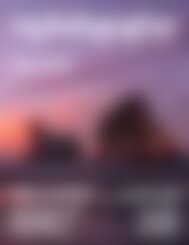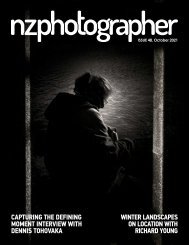NZPhotographer Issue 5, March 2018
As of December 2022, NZPhotographer magazine is only available when you purchase an annual or monthly subscription via the NZP website. Find out more: www.nzphotographer.nz
As of December 2022, NZPhotographer magazine is only available when you purchase an annual or monthly subscription via the NZP website. Find out more: www.nzphotographer.nz
You also want an ePaper? Increase the reach of your titles
YUMPU automatically turns print PDFs into web optimized ePapers that Google loves.
ISSUE 5, <strong>March</strong> <strong>2018</strong><br />
INTERVIEW<br />
with Eva Polak<br />
FACING<br />
FACEBOOK CHANGES<br />
BY EMILY GOODWIN<br />
UNCOVERING INCREDIBLE INDIA<br />
with Susan Blick<br />
HOW TO CAPTURE:<br />
MILKY WAY PHOTOGRAPHS<br />
Astrophotography Tips by Richard Young<br />
LONG EXPOSURE<br />
PHOTOGRAPHY<br />
BY RICHARD BROOKER<br />
<strong>March</strong> <strong>2018</strong> 1
From the Editor<br />
Dear reader,<br />
Join the conversation!<br />
nzphotographer<br />
nzp_magazine<br />
nzp@excio.io<br />
Get in touch!<br />
Taya Iv, Editor<br />
Welcome to <strong>Issue</strong> 5 of NZ<br />
Photography Magazine!<br />
This month, you'll get to<br />
experience the beauty of New<br />
Zealand as well as other parts<br />
of the world. You'll discover Gail<br />
Stent's stunning underwater<br />
photographs, find creative gems<br />
in our interview with Eva Polak,<br />
learn about Facebook changes<br />
and so much more. You'll also get<br />
to see our favourite submissions,<br />
all of which are bound to inspire<br />
you to go out with your camera.<br />
Our community has been thriving<br />
because of your contribution and<br />
support. Thank you for sharing<br />
your stories, talents, and ideas<br />
with us.<br />
We look forward to seeing you in<br />
the next issue!<br />
General Info:<br />
<strong>NZPhotographer</strong> <strong>Issue</strong> 5<br />
<strong>March</strong> <strong>2018</strong><br />
Cover Photo<br />
by Eva Polak<br />
Summer<br />
Publisher:<br />
Excio Group<br />
Website:<br />
www.excio.io/nzphotographer<br />
Group Director:<br />
Ana Lyubich ana@excio.io<br />
Editor:<br />
Taya Iv<br />
Graphic Design:<br />
Maksim Topyrkin<br />
Editorial Assistant:<br />
Emily Goodwin<br />
Advertising Enquiries:<br />
Phone us on 04 889 29 25 or send<br />
us an enquiry hello@excio.io<br />
© <strong>2018</strong> <strong>NZPhotographer</strong> Magazine<br />
All rights reserved. Reproduction<br />
of any material appearing in this<br />
magazine in any form is forbidden<br />
without prior consent of the<br />
publisher.<br />
About <strong>NZPhotographer</strong><br />
Whether you’re an enthusiastic<br />
weekend snapper or a beginner<br />
who wants to learn more, NZ<br />
Photographer is the fun e-magazine<br />
for all Kiwi camera owners – and it’s<br />
free!<br />
2 <strong>NZPhotographer</strong><br />
Disclaimer: Opinions of contributing authors do not necessarily reflect the opinion of the magazine.
CONTRIBUTORS<br />
TABLE OF<br />
RICHARD BROOKER<br />
CONTENTS<br />
4<br />
BEHIND THE SHOT WITH GAIL STENT<br />
Richard is an enthusiast<br />
photographer with too<br />
A NATIONAL TREASURE AWAITS EXPLORERS TO ARTHURS PASS<br />
6 Brendon Gilchrist<br />
much time oh his hands!<br />
He’s fascinated with<br />
capturing movement in<br />
8<br />
INTERVIEW WITH EVA POLAK<br />
a still image.<br />
BACK TO BASICS: UNDERSTANDING SHUTTER PRIORITY<br />
16 Ray Harness<br />
BRENDON GILCHRIST<br />
18<br />
UNCOVERING INCREDIBLE INDIA WITH SUSAN BLICK<br />
FACING FACEBOOK CHANGES<br />
28 Emily Goodwin<br />
HOW TO CAPTURE: MILKY WAY PHOTOGRAPHS<br />
30 Richard Young<br />
LONG EXPOSURE PHOTOGRAPHY<br />
Brendon is the man<br />
31 Richard Brooker<br />
behind ESB Photography.<br />
He treks from sea to<br />
49 READERS SUBMISSIONS mountain, and back<br />
again, capturing the<br />
uniqueness of New<br />
Zealand’s unforgiving<br />
landscape.<br />
RAY HARNESS<br />
RICHARD YOUNG<br />
TAYA IV<br />
EMILY GOODWIN<br />
Ray is an amateur<br />
photographer who has<br />
dabbled in photography<br />
for 45 years. He has a lot<br />
of pre-digital knowledge<br />
under his belt and enjoys<br />
capturing landscape<br />
scenes and animals.<br />
Richard is an awardwinning<br />
landscape and<br />
wildlife photographer<br />
who teaches<br />
photography workshops<br />
and runs photography<br />
tours. He is the founder<br />
of New Zealand<br />
Photography Workshops.<br />
Taya is a portrait<br />
photographer whose<br />
work has been featured in<br />
magazines and on book<br />
covers. In addition to<br />
taking photos, she loves<br />
reading, learning, and<br />
sharing her knowledge<br />
with people like you!<br />
Emily fell into<br />
photography a little<br />
over 10 years ago. She<br />
is passionate about<br />
documenting her travels<br />
and loves to spend time<br />
in nature capturing the<br />
details as well as the<br />
wider views.
Behind The Shot with Gail Stent<br />
GAIL, CAN YOU TELL US A LITTLE ABOUT<br />
YOURSELF AND YOUR PHOTOGRAPHY<br />
CAREER?<br />
I have always been interested in photography<br />
and did a little darkroom work when I was in<br />
high school. When digital cameras came out I<br />
became really interested as all I needed was a<br />
camera and a computer. I had small children<br />
(twins) at that stage, so took a lot of photos of<br />
them and the dogs in-between being a mother<br />
with a part-time job. My photography really took<br />
off when I joined the North Shore Photographic<br />
Society. I taught myself Photoshop and that was<br />
really exciting as I was able to create composites<br />
which I love doing. I have developed my<br />
photography to such an extent that I now teach<br />
photography, Adobe Photoshop and Lightroom<br />
at Auckland Zoo, NZPhotography Tours and<br />
Mairangi Arts Centre. I also exhibit and sell my<br />
fine art pieces, as well as doing photo shoots for<br />
families and underwater portraits.<br />
HOW DID YOU GET STARTED WITH YOUR<br />
UNDERWATER SERIES, AND WHY?<br />
In 2009 I went to the PSNZ National Convention<br />
in Whanganui where I listened to an Australian<br />
guest presenter, Narell Autio. She showed us her<br />
underwater photographs and I was captivated.<br />
Having spent my sporting life underwater<br />
as a synchronised swimmer, this felt like my<br />
domain. I immediately went out and bought<br />
a small Canon G10 camera with housing and<br />
started photographing my daughter and her<br />
teammates. However, it was only really in 2014<br />
that I started creating this type of image.<br />
CAN YOU TAKE US THROUGH SHOOTING<br />
THIS PARTICULAR SHOT?<br />
This shot was taken in an indoor pool. I think we<br />
shot for about 30-45 min - The girls get quite cold<br />
after that. I most often work with girls who are<br />
familiar with the underwater environment and<br />
brief them before we go in about what I want<br />
from them, facial features, body positions etc.<br />
When I work with non-swimmers, I usually go<br />
into shallower water. I work with the model - We<br />
discuss how to make a better image e.g., closer<br />
to the surface, arm positions, etc. I use a mask<br />
and snorkel, so come up for air with the model<br />
and we discuss a repeat or the next move.<br />
WHO IS THE MODEL AND HOW DID YOU<br />
START WORKING TOGETHER?<br />
The model in this image is Katie. I used to coach<br />
her synchronised swimming when she was<br />
younger - She is now a coach herself. She is very<br />
comfortable and relaxed underwater and I love<br />
working with her as she is very flexible and looks<br />
amazing in the water. I also use my daughter<br />
(when she’s in town) and my niece, as well.<br />
WHAT EQUIPMENT ARE YOU USING?<br />
I started off with a Canon G10 and then moved<br />
to a Canon G16. I now use a Sony A7R ii with an<br />
Ikelite housing and a Sony FE 16/35 f4 lens. The<br />
difference in quality is amazing - My images are<br />
now on another level. I tend to use natural light,<br />
but also have a small Lume Cube light that is<br />
waterproof and has amazing power.<br />
I wear a short wetsuit as I get cold really easily,<br />
a weight belt to keep me under (I’m super<br />
buoyant!!), fins (so that I can get back to the<br />
surface!!) and a mask and snorkel. I don’t use full<br />
scuba gear as I need to communicate often with<br />
the model, so come up to the surface to breath<br />
and talk.<br />
ANYTHING ELSE WE SHOULD KNOW?<br />
After the shoot, I always have to post process<br />
in Lightroom as well as Photoshop. Underwater,<br />
everything is blue, so I have to get the White<br />
Balance correct. I prefer doing this in postproduction.<br />
These days I often tend to convert<br />
to B&W or use textures as I find this gives another<br />
dimension to the image.<br />
WHERE CAN WE FIND YOU ONLINE?<br />
www.gailstentphotography.com<br />
www.facebook.com/mifotoshows<br />
www.instagram.com/gailstent<br />
4 <strong>NZPhotographer</strong>
<strong>March</strong> <strong>2018</strong><br />
5
A National Treasure Awaits<br />
Explorers to Arthurs Pass<br />
By Brendon Gilchrist<br />
In the heart of the Southern Alps, which is a short 1 hour<br />
19 minute drive from Greymouth or a 2 hour drive from<br />
Christchurch, you will arrive at a small village called<br />
Arthurs Pass which is on the south western side of Arthurs<br />
Pass National Park.<br />
I have been hiking, climbing and exploring this National<br />
Park for many years. It has always drawn me as a place to<br />
go and explore. The diversity of attractions is so much more<br />
then what most people will ever think, but you need to<br />
walk or climb to reach these stunning destinations.<br />
Within the township you will often see Kea, standing on top<br />
of the railway station, hanging out at the cafe, or outside<br />
the Wobbly Kea. Yes, you read it right, that is the name of<br />
a cafe/restaurant in the village!<br />
Devils Punch Bowl is a large waterfall that towers 131<br />
meters from top to bottom that can be accessed from<br />
the western end of the village, a one hour return walk<br />
from the car park. You'll find great views over to the other<br />
mountains, a lively forest of native birds, and a viewing<br />
platform looking towards the mighty Devils Punch Bowl. The<br />
famous Punch Bowl Branch can be viewed from here. A<br />
focal length on your camera of about 100mm will capture<br />
this world famous branch.<br />
Arthurs Pass offers something for everyone from easy day<br />
walks to difficult mountaineering and rock climbing routes.<br />
There are hiking huts, large tarns (Mountain Lakes) to camp<br />
beside and even hot springs. Where do you begin?<br />
Due to the diversity, it’s one of those places where you’ll<br />
see or do incredible things, but beware of the weather, as<br />
it can and will change quickly.<br />
To start off, Bealey Spur is an easy day walk that walks<br />
through lush bush then enters onto golden tussock tops<br />
overlooking the Waimakarir river and all its braids. The<br />
view is such a classic New Zealand south island river. The<br />
6 <strong>NZPhotographer</strong><br />
hut was built in 1935 and used as a base for high country<br />
sheep farming until 1978 when it was retired and added to<br />
Arthur’s Pass National Park. It is a must do and a must see.<br />
On the other side of the scale is a hike to 3 Alpine Tarns<br />
which are located within Kelly Range and Carol Hut. It's<br />
a solid 3 hours to Carol Hut and an extra 1 hour walk will<br />
get you within reach of the parks best kept secret. You<br />
can camp almost anywhere near the Tarns. On the left<br />
side of the mountain, there is a large slip, if you are careful<br />
you can walk down and stand where water is gushing out<br />
the side of the mountain. You can feel the earth tremble<br />
below you. I remember the taste of the water was so fresh,<br />
suprisingly freezing cold even though it was summer.<br />
Arthurs Pass is also home to Canterbury Mountaineering. A<br />
base for so many peaks, from easy peaks like Avalanche<br />
Peak at 1883 meters high to the more advanced Mount<br />
Temple at 1913 meters mostly needing rope skills. There's<br />
also Mount Rolleston at 2275 meters, or the more longer<br />
access peaks of Mt Murchison at 2302 meters. From<br />
entry level climbing on rock and ice in winter to the<br />
more advanced climbing routes, there are just so many<br />
different peaks to think of, so many valleys to walk up,<br />
so much diversity in wildlife here. You'll find 5 different ski<br />
fields, forests, glacier's and beautiful streams and rivers,<br />
wide open fields of tussock grass, and tarns right below<br />
mountain peaks, or nestled in golden tussock grass.<br />
Standing on top of these mountains looking at more<br />
mountains will give you moments of pure joy as you<br />
ponder life and the world we live in. “We do not climb the<br />
mountain, the mountain climbs us.”<br />
I love this place. Due to its size (1,185 km2) it manages to<br />
have everything. There is no other park in New Zealand<br />
quite as unique as this one.<br />
I hope you will read this, see the photos, and then start to<br />
plan a trip to this unique place.
F/18, 1/20s, ISO400<br />
F/16, 1.3s, ISO100<br />
<strong>March</strong> <strong>2018</strong><br />
7
Interview with<br />
Eva Polak<br />
An Impressionist Photographer On An<br />
Imaginative Journey of Creativity.<br />
EVA, CAN YOU TELL US ABOUT YOURSELF?<br />
I made New Zealand my new home 20 years ago after<br />
leaving Poland. If you had told me the day I landed in<br />
Auckland airport that in a few years time I would run<br />
online impressionist photography courses, write books or<br />
speak in front of people about my work, I would laugh at<br />
you. None of it was even remotely in my plans. In fact I<br />
didn’t even speak English or own a camera back then.<br />
Thanks to photography I really found my place and my<br />
voice here. I live with my husband in West Auckland and<br />
work for a printing company during the day, the rest of<br />
my free time I dedicate to my photography.<br />
WHAT CAMERA EQUIPMENT DO YOU HAVE?<br />
I have a Nikon D300 and D810 and several different<br />
lenses - I really love the Nikkor Nikon AF-S 70-300mm<br />
F/4-F5.6 lens as I can take images in the middle of<br />
the day without needing an ND filter. I use the Sigma<br />
AF 50mm F/2.8 Macro lens for most of my macro<br />
photography. I also have a collection of M42 lenses,<br />
mostly 50mm and 85mm. These lenses create an<br />
amazing variety of effects, from a buttery, soft bokeh to<br />
a crazy swirly bokeh and very interesting lens flares.<br />
If anyone wants to peek inside my camera bag and see<br />
what I do with each lens they can look here:<br />
http://evapolak.com/camerabag.html<br />
HAVE YOU DONE ANY PHOTOGRAPHY COURSES<br />
AND TRAINING OR ARE YOU SELF TAUGHT?<br />
It all started in December 2004 when my husband gave<br />
me a small digital camera for Christmas. I was spending<br />
most of my free time with my camera, always taking<br />
photographs, reading about photography or planning<br />
my next photo shoot. I was enjoying myself immensely<br />
and I even entered a few local competitions with some<br />
success. After a year or so, I felt that I was ready for my<br />
first SLR camera. I wanted to have more control and be<br />
able to experiment with shutter speed and aperture.<br />
I also started to attend photography workshops and<br />
presentations. I was having fun experimenting with<br />
different types of photography, slowly buying new lenses<br />
and other equipment.<br />
By 2007 I was a pretty competent photographer. On<br />
one hand I was enjoying making images, but I also felt<br />
trapped and increasingly frustrated with all the “rules”<br />
of traditional photography. Around that time, I came<br />
across an advert for a workshop at Auckland University,<br />
The Art of Impressionist Photography. I knew instinctively<br />
8 <strong>NZPhotographer</strong><br />
that this was something that I wanted to be doing. And<br />
the rest, as they say, is history.<br />
As I was experimenting with impressionist photography<br />
I very quickly realised that there are certain looks and<br />
effects that I’m attracted to. I started to study my own<br />
work, trying to really pin down my likes and dislikes.<br />
Soon I was using this process in my work to open up<br />
experimentation. I very quickly learned that what starts<br />
as ‘What if?’ could become an image that I love.<br />
CAN YOU DESCRIBE IMPRESSIONIST PHOTOGRAPHY<br />
FOR US – WHAT DOES IT MEAN TO YOU?<br />
The wonderful thing about impressionist photography is<br />
the freedom that it gives you. There is no right or wrong<br />
way to create these images, just guidelines. Also, there is<br />
no need for expensive lenses or special equipment; you<br />
only need a camera with manual control settings.<br />
There is the freedom to work with precision and control,<br />
or to try a spontaneous, experimental approach.<br />
Creating impressionist work doesn’t mean just using<br />
special techniques. You still have to use your sense of<br />
composition and have a knowledge of light, colour and<br />
other elements of visual design to present your subject in<br />
the best possible way.<br />
Success in impressionist photography requires an<br />
understanding of the genre and knowledge of its<br />
strengths and limitations. It is not as easy as some people<br />
might think. The most essential ingredient that you need,<br />
to elevate your images from good to great, is expression.<br />
Actually, the fundamental building blocks of images go<br />
hand in hand with expression, because they allow the<br />
viewer to read and feel the photograph’s mood.<br />
If asked to define this style I would say that impressionist<br />
photography is the first step to abstraction, and the<br />
viewers have a clear idea as to what they are looking<br />
at and respond to emotionally. Photographs should only<br />
suggest detail, rather than focus on it.
<strong>March</strong> <strong>2018</strong><br />
9
DO YOU HAVE A FAVOURITE PIECE OF WORK<br />
THAT YOU HAVE CREATED?<br />
This is a very hard question as there are so many images<br />
that are important to me. Nearly every image leads to a<br />
new discovery or improvement of my work or steers me<br />
in a new direction. I like to work on long term projects<br />
and usually there is only one at a time.<br />
I spent more than three years just perfecting one<br />
technique - ICM (Intentional Camera Movement) with<br />
slow shutter speed. I really wanted to learn all aspects of<br />
this technique like light, different shutter speeds, different<br />
subjects, combinations with other techniques, etc.<br />
Then I moved into a different technique and discovered<br />
dandelions.<br />
I can clearly see how my approach to this one subject<br />
was changing and how my images were evolving.<br />
I finalised this project with a book, The Secret Life of<br />
Dandelions which you can get at http://evapolak.com/<br />
The_Secret_Life_of_Dandelions.html<br />
I had a similar journey with moss. I created a book with<br />
this project as well, called Parallel Universes.<br />
http://evapolak.com/parallel-universes-book.html<br />
I believe that by focusing on one subject for a long time<br />
we can discover and capture the full potential of it.<br />
WHERE’S YOUR FAVOURITE LOCATION FOR<br />
SHOOTING?<br />
The west coast of Auckland is definitely one of my<br />
favorite spots; it’s a very diverse environment of wild<br />
spirit, rolling surf, dramatic cliffs, and distinctive black<br />
sand beaches. For me it is a magical place. I always go<br />
there to recharge and relax.<br />
I also love being in my garden and look at the world<br />
through a macro lens. Beauty is everywhere - we just<br />
need to open our eyes.<br />
ANY TIPS FOR RUNNING A PHOTOGRAPHY<br />
BUSINESS? HOW DO YOU MANAGE YOUR<br />
TIME BETWEEN TEACHING, WRITING BLOG<br />
POSTS, PROMOTION AND ACTUALLY TAKING<br />
PHOTOS?<br />
The secret to any success, in my mind, is consistency.<br />
Small steps but frequent...<br />
I don’t have a lot of time between my full time job<br />
and my private life so I have to organise my time very<br />
carefully.<br />
My students are my priority. They are the most important<br />
people. I do my best to keep them happy and make<br />
sure that they are learning a lot.<br />
I try to make everything else as easy as possible for me...<br />
If I feel I have nothing to say I don’t write my blog post. I<br />
planted a lot of flowers in my garden so I don’t have to<br />
travel anywhere to take pictures which saves me time!<br />
I’m not the most organised person and I’m easily<br />
distracted. My effort this year will be in learning to focus<br />
so I can do more.<br />
10 <strong>NZPhotographer</strong>
<strong>March</strong> <strong>2018</strong><br />
11
ANY TIPS FOR OTHER PHOTOGRAPHERS IN<br />
PROMOTING THEIR WORK AND MAKING<br />
MONEY WITH THEIR PHOTOS?<br />
There are many opportunities to make money with<br />
photography at the moment. The Internet makes it<br />
possible for us to reach a global audience. The trick is<br />
to treat photography as a product and then find the<br />
right people for that product. This is the hardest part,<br />
but if this first step is done right then everything else is<br />
easy.<br />
I research a lot of photographers and artists to find out<br />
how they run their businesses and if possible I adopt<br />
proven strategies. To me knowledge means power so I<br />
invest heavily in personal development.<br />
YOU SEEM TO DO A LOT OF GROUP<br />
EXHIBITIONS, HOW DOES THAT WORK AND<br />
HOW DID YOU GET STARTED?<br />
I got together with three of my friends and we put<br />
together a proposal for the exhibition at UpStairs<br />
gallery in Titirangi.<br />
After the proposal was accepted I spent a lot of time<br />
researching and learning about exhibitions. My goal<br />
was not only to exhibit but also to sell my work, so I<br />
followed all the advice as best I could to reach my<br />
goal.<br />
12 <strong>NZPhotographer</strong><br />
After a few solo exhibitions I received invitations to<br />
do other group shows. I always said, Yes. For the past<br />
few years I have been invited to do a few school<br />
fundraising shows. I love these opportunities as they<br />
are very well organised and run.<br />
I always encourage my students to exhibit their<br />
work, even if the exhibition will be just for family and<br />
friends. Having a show is an exciting and very special<br />
experience. Also it gives you a direction and focus.<br />
YOU CRITIQUE PHOTOGRAPHY, CAN YOU TELL<br />
US A LITTLE ABOUT THAT?<br />
To me, looking at a photograph, especially an<br />
impressionist or abstract one, is like deciphering a<br />
visual message coded in lines, shapes, and colour.<br />
If the message is clear then the image is successful.<br />
If I have trouble understanding the story my job<br />
as a teacher and judge is to honestly point out<br />
the weaknesses and give my best advice for<br />
improvement. Most of the time I see the problem lies<br />
with the composition or overly relying on a specific<br />
technique to tell the story.<br />
For me the hardest part is to ignore my own<br />
preferences and honour someone else’s point of view<br />
and creativity. Art is very personal, and individual<br />
expression is very important. It should bring joy to one’s<br />
life. I’ve seen so many hearts broken by unthoughtful<br />
comments.
WHAT TIPS CAN YOU OFFER PHOTOGRAPHERS<br />
WHO WANT TO TRY THIS STYLE OF<br />
PHOTOGRAPHY?<br />
I would say “Just do it!” Take photographs as often<br />
as possible. Learn from your successes but also from<br />
your failures. Carefully study your own photos, and<br />
ask yourself a lot of “why” questions. Finding your own<br />
personal style is a lifelong, personal journey, so listen to<br />
your heart. As a great photographer, Ernst Haas, once<br />
said, “We see what we know until we know who we<br />
are, then we see what we feel.” Most of all, enjoy your<br />
journey!<br />
WHAT ELSE SHOULD PEOPLE KNOW ABOUT<br />
YOU OR YOUR WORK?<br />
I’m very grateful to my students. Because of them my<br />
understanding of photography, my own processes<br />
and techniques are without doubt greater. So if you<br />
really want to learn something, teach someone else!<br />
I do small group (up to 10 people) weekend<br />
workshops 2-3 times a year. I like small groups as I can<br />
really give individual attention to each participant.<br />
But my main focus is on online courses. These are 5-6<br />
weeks long and are very rewarding for me as I can<br />
see a huge improvement and development of each<br />
student. I try to have no more than 10 students at one<br />
time so I have enough time for each student.<br />
ANY FUNNY PHOTOGRAPHY STORIES TO<br />
SHARE?<br />
One afternoon I went to Piha to photograph the<br />
sunset. As it was a midweek day there was nothing<br />
happening there. The beach was deserted and the<br />
the weather didn’t really promise a spectacular<br />
evening.<br />
As I was strolling along the beach I noticed in the<br />
distance a figure swimming in the ocean. With the<br />
hope of making some images I got closer. To my<br />
surprise, through my 300mm lens I could clearly see<br />
that he was naked. I felt a bit uneasy. It is not in my<br />
nature to photograph unclothed people with my<br />
telephoto lens, even if I’m not capturing any details.<br />
Soon enough I noticed that he saw me. So, I turned<br />
around and walked away. This guy was very quick<br />
getting out of the water and dressing up. He caught<br />
me just before I got to my car and demanded to see<br />
my photos. I apologised and explained to him the<br />
nature of my work.<br />
The expression on his face was priceless as he<br />
discovered that any particular features of his were not<br />
recorded.<br />
<strong>March</strong> <strong>2018</strong><br />
13
DO YOU EVER FEEL THAT YOU LOSE YOUR<br />
CREATIVITY?<br />
Of course, many times. I don’t think that there is an<br />
artist who is immune to that feeling.<br />
When that happened to me for the first time I was<br />
scared and I thought, “This is it. This is the end of my<br />
photography journey.”<br />
Now, I know that I just need to relax and rest.<br />
WHAT ARE YOUR PLANS FOR THE REST OF<br />
<strong>2018</strong>?<br />
I have so many projects I would like to finish this year.<br />
I have three or four books in the making at the<br />
moment... Wonderland’s Impressions - Creative Macro<br />
Photography, Dance Impressions - a collection of<br />
images I created going to ballroom competitions.<br />
Creativity Journal - Tips, ideas, exercises to keep<br />
your creativity alive and last but not least Flowers<br />
Impressions - a flower a day stories. I’m also working on<br />
another online course - Composition in impressionist<br />
and abstract photography.<br />
I have a lot of ideas and sometimes this is a curse, as<br />
very little is actually done!<br />
WHERE CAN WE FIND YOU ONLINE?<br />
www.evapolak.com<br />
www.facebook.com/evapolakimpressionist<br />
www.instagram.com/eva.polak<br />
14 <strong>NZPhotographer</strong>
JOIN AN AWESOME<br />
PHOTOGRAPHY COMMUNITY<br />
NZ $25/year only<br />
Your own portfolio on Excio<br />
30 photos, 100,000 impressions/day<br />
100+ clicks to your website/month<br />
Add your Facebook & Instagram profiles<br />
Member-only offers<br />
Discounts from our partners<br />
Free Lightroom presets<br />
“Early bird” access to events and meetups<br />
Competitions<br />
Get free entry into all competitions and earn<br />
by participating in photo challenges<br />
BECOME A MEMBER<br />
www.excio.io/membership<br />
<strong>March</strong> <strong>2018</strong><br />
15
BACK TO BASICS PART 3<br />
UNDERSTANDING SHUTTER PRIORITY<br />
by Ray Harness<br />
In the last issue, we delved into Aperture Priority and<br />
Depth of Field. Now we explore Shutter Priority and its<br />
uses.<br />
Shutter Priority is where you select the shutter speed<br />
and the camera takes care of the aperture, used<br />
when needed to capture subjects in motion. On most<br />
cameras, shutter priority is designated S or Tv on the<br />
program dial. The speed selected is shown on the top<br />
display panel (if the camera has one), in the viewfinder<br />
itself, and/or on the rear viewfinder. Once in shutter<br />
priority mode, the change to select the speed is usually<br />
made using the spin dial.<br />
Whether you are working with telephoto lenses, fixed<br />
or zoom, without the aid of a tripod and irrespective of<br />
subject matter, rule of thumb says shutter speed should<br />
equal or exceed the lens focal length. For example,<br />
shooting at 100mm should have a shutter speed of 100/<br />
th of a second or faster.<br />
You need to consider what kind of picture you wish to<br />
take, to apply the kind of speed required to achieve<br />
the desired look. For extremely fast moving objects, you<br />
would generally need a fast shutter speed (i.e. to freeze<br />
motion on cars, fast-moving sports, birds in flight etc).<br />
Typically, fast cars would warrant a speed of 1/1500th<br />
of a second or more to freeze motion. To accentuate<br />
the actual speed the car is traveling at, a slower speed<br />
of say 1/750th of a second, with you following the car<br />
(panning the shot) should be enough to stop the action<br />
of the car, speed blurring the background to show the<br />
car’s motion.<br />
16 <strong>NZPhotographer</strong><br />
The same rules can be applied to wildlife photography,<br />
though your shutter speed may not need to be so<br />
extreme unless photographing birds in flight. In this<br />
case, you will be following the bird’s flight as they move<br />
around, so a fast speed is desirable, around 1/1000th<br />
to 1/1250th of a second, maybe more if using a long<br />
telephoto lens.<br />
You should also consider whether you are constricted<br />
by shutter speeds on your camera - This is where the use<br />
of the ISO setting can increase your speeds to what you<br />
may need. Increasing the ISO from 100 to 200 gives an<br />
immediate full stop of shutter speed from for instance<br />
1/125th to 1/250th of a second. You do need to take<br />
into account that higher ISO numbers increase the level<br />
of noise in your pictures and it also reduces the camera’s<br />
dynamic range, though modern cameras have gone a<br />
long way towards minimising these negative effects.<br />
If you’re feeling a little daunted at using shutter priority<br />
mode don’t despair as many top photographers (even<br />
sports photographers) shoot purely using aperture<br />
priority. The latitude in aperture settings allows you to set<br />
an aperture that will produce the desired shutter speed<br />
unless you find yourself in a rare situation when you need<br />
a very specific speed.<br />
People ask what are the best apertures, or speeds to<br />
use in varying picture scenarios, but so much depends<br />
on the amount of light available that it is almost<br />
unanswerable. It’s something that you need to explore<br />
and pracise so get out there and have a go! If at first,<br />
you don’t succeed, try again, and again and again.<br />
You will achieve what you are aiming for with more<br />
experience behind the camera.
<strong>March</strong> <strong>2018</strong><br />
17
UNCOVERING INCREDIBLE INDIA<br />
with Susan Blick<br />
India, incredible India they tell us in the<br />
advertisements and they’re not wrong. Most of us<br />
have probably thought about going to India at<br />
some point in our lives. After all, the saying goes,<br />
“You haven’t travelled till you’ve been to India”.<br />
Another one says, “You can’t die happy if you haven’t<br />
seen the Taj Mahal”. I’m not sure about that, but<br />
certainly going to India gives you new and thoughtful<br />
perspectives on life and faith.<br />
India is like a love-hate relationship. You love it when<br />
you arrive, then you can’t wait to leave. Once you<br />
have left, you’re planning a return. It’s a drug, a<br />
stimulant. It stimulates your senses, all of your senses.<br />
It fuels creativity and teaches patience. It’s what you<br />
need, if you don’t like being bored, and most of all,<br />
if you’re looking for something new to inspire your<br />
photography.<br />
I’ve been travelling to India since 1998. On that first<br />
visit I entered the country overland from Nepal and<br />
traveled down to Varanasi and then West all the way<br />
to Jaisalmer and into the Thar Desert. By the time my<br />
month of travel was up, I was hooked! Since then I’ve<br />
been visiting on average every few years.<br />
I generally travel with a pretty compact photography<br />
kit, but naturally it depends what region I am visiting.<br />
For a street-based India tour I take either my Canon<br />
6D or 5D Mark 3, the 16-35mm F/2.8 III for landscapes<br />
and the 24-105mm F/4 for street shots. If I am visiting<br />
a mountainous area like Ladakh I will trade the 24-<br />
105mm for a longer telephoto like the 70-200mm<br />
F/2.8. I always take at least one neutral density filter,<br />
usually the 6 stop as it’s more versatile, and always a<br />
graduated filter, usually the soft grad 1.2. I used Lee<br />
Filters for many, many years, but have fairly recently<br />
moved over to Nisi as I find them far superior. I always<br />
travel with one of my tripods, usually the Sirui tripod<br />
with ball-head for international travel as it’s that much<br />
lighter.<br />
18 <strong>NZPhotographer</strong>
This shot (above) was taken in Khari Baoli the largest<br />
spice market in all Asia. This humble Holy man sets up<br />
his little puja offering stall just after dawn and goes<br />
through a ritual that I was lucky enough to witness<br />
and experience. He only does this once a day. He<br />
awakens the Gods or spirits by using little balls of<br />
explosives - He throws them into the candle and they<br />
combust in a flurry of flames. He runs his hands through<br />
the flames. I squatted down the on road beside<br />
him and he happily allowed me to photograph<br />
his process. I find Indians are like this, they’re very<br />
welcoming and kind, so long as you show some<br />
respect. Afterwards, local shop owners came by and<br />
gave him small amount of rupees for which he blessed<br />
them. Moments like this stay with you!<br />
I find the best time of day to explore in the city is early<br />
morning. Mornings are cool and people awake in a<br />
good mood. You feel at peace as you wander the<br />
streets looking for imagery. You’re welcomed with<br />
Namastes, and you feel you’ve found something<br />
more soulful than the cacophony that envelopes<br />
the streets by midday. People are going about their<br />
business, some are rushing to work, others are hanging<br />
around waiting to open shops. The streets are littered<br />
with paper and debris from the day before. Street<br />
sweepers come by and fine dust particles are lifted<br />
into the air with shafts of light reflecting through them.<br />
Who knew pollution could be so photogenic!<br />
<strong>March</strong> <strong>2018</strong><br />
19
20 <strong>NZPhotographer</strong>
Transport in all its known forms pass by, with bullock<br />
and horse carts jostling for space on the crowded<br />
roads among cycle-rickshaws, cars, trucks and every<br />
man and street dog. There isn’t anywhere to look<br />
where nothing is happening. Your eyes, all your senses<br />
in fact, are beaming, you’ve never been more awake<br />
or alert to your environment. You feel consumed with<br />
adventure and excitement, and this is just the first day!<br />
I couldn't help but name this image (bottom left) The<br />
Backstreet Boys! As a foreigner with a camera you<br />
tend to attract attention. Mostly on the streets you<br />
find curious young to middle-aged men. They often<br />
want to know where you’re from, what you do, and<br />
if you have children. Having children is obviously<br />
more important in their culture than mine, they usually<br />
can’t fathom why I wouldn’t want to have kids! So<br />
it was during my wanders I came across this group<br />
of lads, doing what… I have no idea, but quickly<br />
they gathered around and I was like the paparazzi<br />
snapping away happily as they laughed and joked<br />
to stall holders either side of the street. They spoke<br />
broken English, and mixed with my bad Hindi, together<br />
we smiled and laughed as I captured this candid<br />
moment. Moments in India are almost always candid,<br />
images are a record of a split second in time. A time<br />
that you forever recall with a smile.<br />
Painted in the colours of the Indian flag, a pedestrian<br />
swing bridge (above) stretches high over the river<br />
Ganges in Rishikesh. I sit at an open-air German<br />
Bakery sipping a cappuccino and watching<br />
pilgrims make their way across the bridge. Indian<br />
photographers wait to take Indian tourists’ photos,<br />
they print the shots while the tourists visit the temples.<br />
They’re only in town for 24 hours. I spent time<br />
chatting with them, they’re no different than the<br />
photographers we have in New Zealand at any tourist<br />
site like the Queenstown cable car or at the Sky Tower<br />
in Auckland.<br />
Vendors on this side of the bridge sell dried corn,<br />
peanuts, flowers and other knick-knacks to be offered<br />
up to the Gods for puja once the pilgrim makes it over<br />
to the temple on the other side. Before they reach the<br />
temple however they must run the gauntlet of Rhesus<br />
Macaque monkeys waiting to relieve them of their<br />
goodies. The monkeys work in gangs, and although<br />
mostly harmless they are quite frightening. If you’re<br />
carrying any food at all they will snatch the quarry<br />
from your hand.<br />
<strong>March</strong> <strong>2018</strong><br />
21
The pulsating streets of New Delhi are alive with colour.<br />
It’s quite humorous sitting back enjoying my morning<br />
coffee watching the next poor unsuspecting tourist<br />
being mugged in broad daylight by the monkeys! I<br />
love Rishikesh with its temples, Holy men, the Beatles,<br />
cows and monkeys… Life here in the foothills of the<br />
Himalaya is idyllic as the bells at the temple across the<br />
river chime in a spiritual trance the gorgeous days just<br />
saunter by.<br />
These days I’m running photo tours to some of the<br />
most photogenic and culturally significant parts of<br />
India and I’d love to take you with me. My tours<br />
are different from most. Firstly, they are reasonably<br />
priced, and secondly, we are travellers not tourists<br />
while in India. There is a huge difference and one you<br />
can best appreciate once there. We interact with<br />
common people and I take you into the back streets<br />
where the photo ops are gold and the best memories<br />
are made.<br />
Join me on my next available departure in April 2019,<br />
when we’ll visit incredible Mughal dynasty sights like<br />
the Taj Mahal and the Jama Masjid. We’ll venture<br />
North, first to Rishikesh, where the Holy Ganges runs<br />
blue, and then into the Indian Himalaya taking in the<br />
great expanses of the mountainous landscapes that<br />
make up Ladakh, the number one up-and-coming<br />
travel destination in the World!<br />
For more information on traveling with me whether in<br />
India or NZ visit www.susanblick.com<br />
www.facebook.com/susanblickphoto<br />
www.instagram.com/phomadic<br />
22 <strong>NZPhotographer</strong>
Susan Blick is an English teacher, and<br />
a landscape and travel photographer<br />
based in Auckland, New Zealand. She<br />
has visited 39 countries - many of them<br />
numerous times - and has resided in seven.<br />
She was New Zealand Geographic’s<br />
Landscape Photographer of the Year<br />
in 2015 and notably, won gold awards<br />
at the Sydney International Exhibition of<br />
Photography for Landscape and the Prix<br />
de la Photographie Paris in the Travel<br />
and Tourism category in 2015 and 2016<br />
respectively.<br />
Susan enjoys documenting stories<br />
behind small NGOs (non-governmental<br />
organisations) and has studied visual<br />
journalism.<br />
<strong>March</strong> <strong>2018</strong><br />
23
A Sadhu in Rishikesh enjoys his chillum of ganja<br />
24 <strong>NZPhotographer</strong><br />
The Taj Mahal at sunrise, looking down the Yamuna River
An old man feels grief as his mother is burned<br />
on a funeral pyre in Agra.<br />
<strong>March</strong> <strong>2018</strong><br />
25
The Taj Mahal at dusk<br />
26 <strong>NZPhotographer</strong><br />
Sadhus line the side streets in<br />
Rishikesh, reminding you of chilled<br />
times and Rasta ways
A sadhu with the most beautiful smile - This<br />
man was genuinely filled <strong>March</strong> with peace. <strong>2018</strong><br />
27
FACING FACEBOOK CHANGES<br />
At the start of the year, Mark Zuckerberg<br />
announced it was time to ‘Fix Facebook’ due<br />
to most people’s newsfeeds being overrun with<br />
content from businesses and brands with posts from<br />
friends and family often getting buried. The news feed<br />
algorithm will be altered so that it no longer prioritises<br />
delivering relevant content, instead, the focus will be<br />
on creating meaningful interactions with friends and<br />
family and between users, such as members in groups.<br />
Essentially Facebook is going back to its roots, it<br />
doesn’t want to give users a passive experience<br />
anymore and will cut back on the amount of content<br />
a Facebook user sees from brands, businesses and<br />
media outlets knowing full well that this means people<br />
are going to spend less time on the platform. It would<br />
seem that using Facebook for entertainment purposes<br />
is going to become a thing of the past, mindlessly<br />
scrolling through and hitting like is no longer enough<br />
for FB though I’m sure they won’t be stopping the<br />
advertising and ability to boost posts with $$!<br />
What does this mean for photographers who have<br />
built a following on their FB page? It’s difficult to<br />
guesstimate just how bad the change is going to be,<br />
but it’s a safe bet to say it’s going to become more<br />
difficult (and probably more expensive) to get your<br />
photography seen by your fans - Anyone who relies<br />
28 <strong>NZPhotographer</strong><br />
By Emily Goodwin<br />
solely on Facebook to promote their work could be in<br />
for a big shock and a crash in their earnings.<br />
Facebook has been experimenting with the idea<br />
of a second ‘explore’ feed where all ‘professional<br />
publishers’ posts (anyone who publishes from a<br />
Facebook page rather than a personal account) will<br />
be placed, meaning users have to navigate over to<br />
a 2 nd tab to see updates from the pages they like and<br />
follow.<br />
Even if users do get used to the idea of a second news<br />
feed, we’re told that pages with posts that people<br />
don’t interact with or comment on are going to see<br />
the biggest decrease in distribution. At the same<br />
time, Facebook has said that posts that gain likes and<br />
shares but nothing else will be discouraged. This move<br />
is to help stop the spread of ‘fake news’ and clickbait<br />
posts. As a FB user that’s great, but as a photographer<br />
running a small-business it leaves me wondering how<br />
I can make my content engaging enough so that<br />
people will leave meaningful comments, without<br />
turning it into ‘engagement bait’ which is now a huge<br />
no-no.<br />
It would seem the way forward is through live video<br />
- Facebook users spend 3 times longer watching live<br />
video than a video that’s no longer live (or never was
live), and users comment 10 times more during live<br />
video which is classed as meaningful engagement.<br />
Many of us cannot afford to pay to ‘boost’ our posts<br />
or to advertise on FB which is the current trend if you<br />
want to be seen, so with the upcoming newsfeed<br />
changes I think many people will be jumping off the FB<br />
ship to find other ways to connect with their audience<br />
and promote their work.<br />
No matter what you decide to do here are some<br />
ideas and options for you on how to proceed:<br />
Continuing with Facebook:<br />
Do:<br />
• Get started with Live Video.<br />
• Ask followers questions or advice to create<br />
meaningful conversations.<br />
• Consider if you can promote your work purely<br />
through a personal account.<br />
• Consider creating a Group Page - Groups will likely<br />
get preference over pages.<br />
Don’t:<br />
• Post updates just for the sake of posting something<br />
new.<br />
• Create posts in order to get likes/shares – Posts<br />
now need to create meaningful conversation via<br />
comments.<br />
Staying Connected Without Facebook:<br />
Here are some alternative options for you to stay<br />
engaged with your fans. We deliberately have not<br />
included social media sites since even Instagram has<br />
said they will be making changes by the end of the<br />
year to their feed.<br />
Excio – This is NZP’s very own sister app so we’re a little<br />
biased on how good it is! With Excio your images are<br />
displayed on users mobile phone home screens – No<br />
need for this visual loving audience to open an app<br />
or visit a website to see your new work, it appears<br />
slap-bang in front of their face every time they look at<br />
their phone with a description and links to your site/<br />
social media pages – You can even add audio files to<br />
describe your work and connect with your audience<br />
that way!<br />
500px – A portfolio site for photographers to display<br />
their best work with community and marketplace<br />
features.<br />
Blog/Website – The best thing about having your own<br />
website/blog is that it’s yours – A company cannot<br />
come along and change things up, well, excluding<br />
Google of course!<br />
Email Newsletter – An oldie but still a goodie since<br />
everyone is still connected to their inbox daily if not<br />
24/7.<br />
<strong>March</strong> <strong>2018</strong><br />
29
How To Capture: Milky Way Photographs<br />
ASTROPHOTOGRAPHY TIPS BY RICHARD YOUNG<br />
Milky Way over Mt Sefton & Mt Cook<br />
18mm lens, ISO 3200, f3.5, 25s<br />
SHOOT UNDER A DARK SKY:<br />
A dark sky without any light pollution is the most<br />
important requirement to see the Milky Way, let<br />
alone photograph it. For the darkest skies, you will<br />
also need to be shooting near or during a new<br />
moon.<br />
LOCATE THE GALACTIC CENTRE:<br />
The time of year will affect what parts of the<br />
Milky Way you can see. In New Zealand, the<br />
galactic core of the Milky Way is only visible from<br />
February to October, with June and July being<br />
the best when the core is at its brightest. Use a<br />
mobile app to help you plan your shot of the<br />
Milky Way.<br />
FIND A SUBJECT:<br />
Just because you are photographing at night<br />
doesn’t mean you should forget about the<br />
foreground, it is this that will make the photograph.<br />
For the best shots, frame the Milky Way lining up<br />
over a landscape, mountain, hut or even a person.<br />
Don't forget the Milky Way will move across the sky<br />
during the night.<br />
DON’T BLUR THE STARS:<br />
To photograph the Milky Way, you’ll need to use<br />
a high ISO (ISO 3200) and a large aperture (f2.8)<br />
to capture as much light as possible. Select the<br />
correct shutter speed so not to blur the stars, due<br />
to the rotation of the earth. There are various<br />
rules for how long this time is and it depends on<br />
your camera and lens focal length, 25 seconds is<br />
a good starting point on a wide angle lens.<br />
JOIN NEW ZEALAND PHOTOGRAPHY WORKSHOPS ON AN 4-DAY ASTROPHOTOGRAPHY<br />
MASTERCLASS AT MT COOK ON THE 10TH - 13TH AUGUST <strong>2018</strong>.<br />
30 <strong>NZPhotographer</strong>
LONG EXPOSURE PHOTOGRAPHY<br />
I<br />
remember the moment this became a thing for me.<br />
A friend came down from Hamilton and together<br />
with a few other friends we went out to Princess Bay<br />
to take photos. Brent took his camera, placed it on<br />
a tripod down amongst the rocks and pools of water<br />
and casually announced that he would be taking a<br />
three-and-a-half-minute photo.<br />
Huh? Three and a half minutes?<br />
Well, three and a half minutes later, I was looking at<br />
the back of his camera and bam, long exposures<br />
became a thing.<br />
They are fascinating. You can SEE what is happening<br />
in a long exposure even through nothing is moving.<br />
They give a sense of motion, time, change and<br />
movement… all in a static image. Clouds drag their<br />
way across the sky, waves are perpetually crashing,<br />
rivers become glass…<br />
The first long exposure photograph I took is still<br />
a favourite of mine. I was down at Plimmerton<br />
foreshore experimenting with a 10 stop filter that I had<br />
purchased and was shooting the sunset. 105 seconds<br />
worth of water movement, cloud movement and a<br />
sun corona to boot.<br />
By Richard Brooker<br />
WHAT YOU WILL NEED.<br />
• Camera + Lens<br />
• A Tripod<br />
• A filter with a high enough ND value for the image<br />
you want to capture.<br />
• Patience.<br />
• Maybe a little luck.<br />
WHAT TO DO.<br />
Decide what you want to photograph.<br />
As long exposure photographs are best used to<br />
portray movement, you want something in your scene<br />
that moves. Be it a car, a cloud, a wave, even a<br />
child, just something. The scene will also drive your<br />
lens selection but there is no requirement that you<br />
use a wide-angle lens. Primarily long exposures are<br />
landscapes so a wide-angle lens is used, but I have<br />
taken long exposures on focal lengths ranging from<br />
16mm right through to 400mm.<br />
<strong>March</strong> <strong>2018</strong><br />
31
Compose the photograph.<br />
A little backwards here. Take the photograph... before<br />
you take the photograph? Yes. This allows you to get<br />
composition nailed and workout the metering (it also<br />
lets you compose the picture without having the filter<br />
on the front – not as easy as it sounds). Attach your<br />
camera to a tripod (this is a must – it will avoid camera<br />
shake), set your aperture and ISO to achieve the<br />
affects you are looking for and take a note the shutter<br />
speed that results in a correctly exposed photograph.<br />
Photo looks good? Prepare for some long exposure<br />
magic.<br />
Attach the filter.<br />
Filters come in all shapes and sizes. If you are<br />
beginning I would recommend purchasing a cheaper<br />
set before spending serious money, find out whether<br />
the long exposure genre is for you. As you progress in<br />
skill, there are high-end kits available; Lee filters, Nisi<br />
filters. Each set has advantages and disadvantages. I<br />
currently have Nisi v5 filter set; a 6 stop, 10 stop and a<br />
3 stop hard grad. I will explain more about those later.<br />
Work out the exposure time.<br />
A filter is, simply put, sunglasses for your camera. They<br />
filter out a nominal amount of light that will allow you<br />
to keep the shutter open for longer. They come in<br />
different strengths and can be measured in a couple<br />
of ways. Calculating the correct exposure time based<br />
on the strength of your filter is critical for maintaining<br />
the correct exposure.<br />
CLICK!<br />
Take the photo… do a happy dance…<br />
Be prepared to get frustrated, to give up, to think that<br />
it’s too hard. I did, several times… but each time I<br />
quit, I came back. It takes perseverance to get right,<br />
but the results will be well worth it.<br />
TECHNICAL: HOW TO CALCULATE THE<br />
CORRECT EXPOSURE TIME.<br />
3 stop, 6 stop, 10 stop, ND8, ND64, ND1000, how does<br />
the strength of the filter affect the exposure time?<br />
Well… there is a formula.<br />
t n<br />
= t 0<br />
x 2 stops<br />
This is simpler than it looks. The new exposure time, t n<br />
, is<br />
equal to the original exposure time (as worked out in<br />
your composing photograph), t 0<br />
, times 2 to the power<br />
of the strength of your filter. For example, if your<br />
unfiltered exposure time is 1/100th of a second and<br />
you’re using a 10 stop filter, the corrected exposure<br />
time is calculated by: t n<br />
=(1/100 x 2 10 ) which results<br />
in an exposure time of 10 seconds. A ten second<br />
exposure can include quite a bit of movement.<br />
If your filter strength is measured using an ND value,<br />
they have already calculated the 2 stops for you. The<br />
exposure time is now calculated by multiplying the<br />
unfiltered exposure time by the ND value:<br />
t n<br />
= (1/100 x 1000) which also results in an exposure<br />
time of 10 seconds.<br />
Easy!<br />
EXAMPLES OF LONG EXPOSURES AT VARIOUS<br />
FOCAL LENGTHS.<br />
Long exposures can be photographs of anything, but<br />
for me, right from day one, mine had to have water<br />
in them. Beaches, rivers, waterfalls, rain… I find the<br />
movement of water to be calming.<br />
LONG EXPOSURES ARE GOOD FOR THE SOUL!<br />
Plimmerton Boat Ramp<br />
32 <strong>NZPhotographer</strong><br />
F/22, 30s, ISO400
A river in the Tongariro National Park somewhere<br />
F/22, 2,5s, ISO50<br />
Old Tokaanu Wharf<br />
F/11, 60s, ISO50<br />
<strong>March</strong> <strong>2018</strong><br />
33
34 <strong>NZPhotographer</strong>
Ngatuhoa Lodge - Whio Falls:<br />
F/8, 20s, ISO100<br />
This is a panorama of several photos.<br />
<strong>March</strong> <strong>2018</strong><br />
35
Ngatuhoa Lodge – Pump House Falls:<br />
F/22, 8s, ISO 50<br />
Tongariro National Park – Kaimanawa Road:<br />
F/11, 60s, ISO50<br />
36 <strong>NZPhotographer</strong>
Tongariro National Park:<br />
F/5.6, 4s, ISO100<br />
<strong>March</strong> <strong>2018</strong><br />
37<br />
A vertical panorama of 3 photographs.
Waikanae Beach<br />
F/22, 30s, ISO100<br />
Te Mata Peak<br />
F/22, 20s, ISO100<br />
38 <strong>NZPhotographer</strong>
Paraparaumu Beach<br />
F/7.1, 30s, ISO100<br />
Lake Wairarapa<br />
F/18, 30s, ISO50<br />
<strong>March</strong> <strong>2018</strong><br />
39
Titahi Bay<br />
F/11, 10s, ISO200<br />
Plimmerton<br />
F/11, 30s, Titahi ISO200 Bay<br />
40 <strong>NZPhotographer</strong>
Cape Palliser<br />
F/8, 1s, ISO200<br />
Plimmerton<br />
F/22, 5s, ISO1600<br />
<strong>March</strong> <strong>2018</strong><br />
41
42 <strong>NZPhotographer</strong>
Plimmerton – F/22, 2s, ISO 50<br />
<strong>March</strong> <strong>2018</strong><br />
43
44 <strong>NZPhotographer</strong>
Plimmerton<br />
F/5.6, 5s, ISO100<br />
<strong>March</strong> <strong>2018</strong><br />
45
EXTRAS:<br />
The following are not long exposure photographs, but they exhibit many of the same properties. These rely on<br />
the speed of the moving objects which allow a shorter shutter speed while obtaining the desired amount of<br />
movement. Neither of these was shot with a ND filter attached.<br />
Home<br />
F/18, 1/15s, ISO50<br />
Home<br />
F/2.8, 1/800s, ISO100<br />
46 <strong>NZPhotographer</strong>
<strong>March</strong> <strong>2018</strong><br />
47
Best<br />
Summer<br />
Shot<br />
COMPETITION<br />
Partners<br />
Show us your best photographs taken this Summer<br />
and be in for the chance to win!<br />
1st Place $100 printing voucher<br />
2nd Place $50 printing voucher<br />
3rd Place $50 printing voucher<br />
Prizes are proudly brought to you by Wellington Photographic Supplies<br />
Competition runs 1st-20th <strong>March</strong> <strong>2018</strong><br />
Submit up to 3 images<br />
48 <strong>NZPhotographer</strong><br />
To enter or find out more, visit<br />
www.excio.io/submit
PORTFOLIO<br />
Best readers' submissions this month<br />
<strong>March</strong> <strong>2018</strong><br />
49
50 <strong>NZPhotographer</strong>
MARAETAI WHARF<br />
30S, NIKON D810 WITH B+W FILTER<br />
Love going to to this wharf to shoot the sunset.<br />
Alex Moore<br />
<strong>March</strong> <strong>2018</strong> 51
52 <strong>NZPhotographer</strong>
SUNRISE WRIGHTS LAKE 5166<br />
F/8, 1/20s, ISO100<br />
Sunrise on Wrights Lake, Sierra Nevada Mountains<br />
Brian Fox<br />
<strong>March</strong> <strong>2018</strong> 53
54 <strong>NZPhotographer</strong>
MA I RUNGA I MA<br />
F/9, 1/200s, ISO800<br />
Ma i runga i ma (White on White)One of a series of White on White images of my favourite<br />
model Levana. White background, White make-up, White Clothes with varying backgrounds<br />
to enhance the High Key aspects of the shoot.<br />
Cheryl Muirson<br />
<strong>March</strong> <strong>2018</strong> 55
56 <strong>NZPhotographer</strong>
PADDLES<br />
1/250s, ISO100<br />
Shot at the Rangariri Pa site - this is where one of the fiercest battles of the<br />
Waikato war was fought between the Maori and the British with many casualties<br />
on both sides. Part of the Pa is now an historical reserve.<br />
Diane Beguely<br />
<strong>March</strong> <strong>2018</strong> 57
58 <strong>NZPhotographer</strong>
RUSSEL FALLS - TASMANIA<br />
F/14, 0.6s, ISO125<br />
One of the most accessible, and beloved, waterfalls in Tasmania is Russell Falls, situated<br />
within the Mount Field National Park, and definitely spectacular!<br />
Dominic Scott<br />
<strong>March</strong> <strong>2018</strong> 59
60 <strong>NZPhotographer</strong>
'THE NUT' - STANLEY TASMANIA<br />
F/13, 30s, ISO200<br />
'The Nut' - an old volcanic plug at Stanley in Tasmania<br />
photographed in early morning light.<br />
Dominic Scott<br />
<strong>March</strong> <strong>2018</strong> 61
62 <strong>NZPhotographer</strong>
THE SURVIVOR<br />
F/20, 13s, ISO50<br />
Binalong Bay is situated at the southern end of the beautiful Bay of Fires. The area<br />
is one of the most scenic and beautiful places in Tasmania, from the blue sea<br />
and fine white sand to the orange-tinged boulders that hug the coast.<br />
Dominic Scott<br />
<strong>March</strong> <strong>2018</strong> 63
64 <strong>NZPhotographer</strong>
BAY OF FIRES - TASMANIA<br />
F/20, 13s, ISO50<br />
Another shot taken at Binalong Bay at the southern end of the beautiful Bay of Fires.<br />
Dominic Scott<br />
<strong>March</strong> <strong>2018</strong> 65
HOGARTH FALLS - TASMANIA<br />
F/11, 30s, ISO100<br />
One of Tasmania's 60 Great Short Walks, this walk<br />
starts at the top of Peoples Park in Strahan and is a<br />
gentle, meandering stroll through sweet-smelling<br />
bush to this delightful waterfall. Light conditions<br />
were good with overcast skies and occasional<br />
rain just to keep it interesting! I love the water swirl<br />
patterns the long exposure has created<br />
Dominic Scott<br />
66 <strong>NZPhotographer</strong>
<strong>March</strong> <strong>2018</strong><br />
67
68 <strong>NZPhotographer</strong>
LAKE PEARSON<br />
F/18, 30s, ISO100<br />
Lake Pearson, Flock Hill Station, Cass. 5 shot panorama<br />
Dominic Stove<br />
<strong>March</strong> <strong>2018</strong><br />
69
70 <strong>NZPhotographer</strong>
LAST LOAD<br />
F/10, 1/80s<br />
Truck, Lees Valley<br />
Dominic Stove<br />
<strong>March</strong> <strong>2018</strong> 71
72 <strong>NZPhotographer</strong>
BUDDIES IN THE AIR<br />
F/8, ISO300<br />
Close contact with a pair of Starlings<br />
Eric Pollock<br />
<strong>March</strong> <strong>2018</strong> 73
74 <strong>NZPhotographer</strong>
ENGELA<br />
Fine art photograph of soft pink and yellow Peonies. This image is named after my mother in law,<br />
most of my recent floral images are named after influential woman in my family.<br />
Marina De Wit<br />
<strong>March</strong> <strong>2018</strong><br />
75
76 <strong>NZPhotographer</strong>
INA<br />
Fine art photography of soft pink and purple Peonies named after my mum.<br />
Marina De Wit<br />
<strong>March</strong> <strong>2018</strong> 77
78 <strong>NZPhotographer</strong>
CAREFREE<br />
F/5.6, 2000s, Auto ISO<br />
This photo depicts the character and freedom expressed in a way Dolphins do best<br />
Mark Watson<br />
<strong>March</strong> <strong>2018</strong> 79
80 <strong>NZPhotographer</strong>
CHEEKY<br />
F/10, 1/400s, ISO800<br />
Sparrow showing off its breakfast<br />
Steve Harper<br />
<strong>March</strong> <strong>2018</strong> 81
82 <strong>NZPhotographer</strong>
LOOKING EAST<br />
F/8, 13s, ISO800<br />
Looking east prior to sunrise from Maungakiekie, Auckland<br />
Steve Harper<br />
<strong>March</strong> <strong>2018</strong> 83
84 <strong>NZPhotographer</strong>
SKY AND WATER<br />
Reflection of the sky over water surface near Lake Campillo, at the south of Madrid, Spain.<br />
Tomas Fernandez<br />
<strong>March</strong> <strong>2018</strong> 85
86 <strong>NZPhotographer</strong>
THE CAMERA IS AN<br />
INSTRUMENT THAT<br />
TEACHES PEOPLE<br />
HOW TO SEE<br />
WITHOUT A CAMERA<br />
Dorothea Lange<br />
<strong>March</strong> <strong>2018</strong><br />
87


















